最近公司的项目上有个需求,还挺有分享价值的,这边做个记录。需求大致如下,下面的一个流程图,点击条件线上选择的内容,必须是前面配置过的节点,如果不是,需要在保存的时候做强校验提示。

需求其实很明确,抽象出来就是获取图中两个顶点之间所有可达路径的顶点集合,大家可以思考下,该如何实现?这里面涉及到了数据结构中图相关知识,而数据结构算法也是本事最大的弱项,还是废了我一番工夫。
实际上,看到这个需求就很容易想到我们的有向图,那么在java中该用怎么样的数据结构表示有向图呢?在恶补了一番图相关的知识以后,最终确定用"邻接表"的方式实现。邻接表是图的一种最主要存储结构,用来描述图上的每一个点。
我们假设下面的一个有向图:

那么可以抽象出下面的数据结构:

不知道大家发现规律了吗,每个顶点关联了它关联的其他顶点,比如A通过边关联了B,C,D, 可以理解为A有3条边,他们的目标顶点是B,C,D,那如何用java表示呢?
1.顶点类Vertex
/**
* 顶点
*/
@Data
@AllArgsConstructor
@Accessors(chain = true)
@NoArgsConstructor
class Vertex {
/**
* 顶点id
*/
private String id;
/**
* 顶点的名称
*/
private String name;
/**
* 顶点发散出去的边信息
*/
private List<Edge> edges = new ArrayList<>();
}成员变量edges表示顶点关联的所有的边
2.顶点关联的边类Edge
/**
* 边
*/
@Data
@AllArgsConstructor
@Accessors(chain = true)
@NoArgsConstructor
class Edge {
/**
* 边的目标id
*/
private String targetVertexId;
/**
* 边的id
*/
private String id;
/**
* 边的名称
*/
private String name;
}成员变量targetVertexId用来存储边的目标顶点id
3.创建有向图DirectedDiagraph
/**
* 有向图
*
* @author alvin
* @date 2022/10/26
* @since 1.0
**/
@Data
@Slf4j(topic = "a.DirectedDiagraph")
public class DirectedDiagraph {
/**
* 有向图的的顶点信息
*/
private Map<String, Vertex> vertextMap = new HashMap<>();
/**
* 边的数量
*/
private int edgeNum;
/**
* 添加顶点信息
*
* @param vertexId 顶点的id
* @param vertexName 顶点的名称
*/
public void addVertex(String vertexId, String vertexName) {
if (StrUtil.isEmpty(vertexId)) {
throw new RuntimeException("顶点id不能为空");
}
Vertex node = new Vertex().setId(vertexId).setName(vertexName);
// 添加到有向图中
vertextMap.put(vertexId, node);
}
/**
* 添加边信息
*
* @param fromVertexId 边的起始节点
* @param targetVertexId 边的目标节点
* @param edgeId 边id
* @param edgeName 边名称
*/
public void addEdge(String fromVertexId, String targetVertexId, String edgeId, String edgeName) {
if (StrUtil.isEmpty(fromVertexId) || StrUtil.isEmpty(targetVertexId)) {
throw new RuntimeException("边的起始顶点或者目标顶点不能为空");
}
Edge edge = new Edge().setTargetVertexId(targetVertexId).setId(edgeId).setName(edgeName);
// 获取顶点
Vertex fromVertex = vertextMap.get(fromVertexId);
// 添加到边中
fromVertex.getEdges().add(edge);
// 边的数量+1
edgeNum++;
}
/**
* 添加边信息
* @param fromVertexId 边的起始节点
* @param targetVertexId 边的目标节点
*/
public void addEdge(String fromVertexId, String targetVertexId) {
this.addEdge(fromVertexId, targetVertexId, null, null);
}
/**
* 获取图中边的数量
*/
public int getEdgeNum() {
return edgeNum;
}
}vertextMap存储图中的顶点信息addVertex() 方法用来添加顶点数据addEdge()方法用来添加边数据回到前言的需求,目前图的数据模型已经创建好了,现在需要实现计算两个顶点之间可达路径的所有顶点集合,直接上代码。
由于用到的参数比较多,这边封装了一个算法的类CalcTwoVertexPathlgorithm
calcPaths()方法就是算法的核心入口allPathList中存放了所有可达的路径列表。printAllPaths()方法打印所有的路径。getAllVertexs()返回所有可达的顶点集合。/**
* 计算两个顶点之间路径的算法
*/
@Slf4j(topic = "a.CalcTwoVertexPathlgorithm")
class CalcTwoVertexPathlgorithm {
/**
* 起始顶点
*/
private String fromVertexId;
/**
* 查询的目标顶点
*/
private String toVertextId;
/**
* 当前的图
*/
private DirectedDiagraph directedDiagraph;
/**
* 所有的路径
*/
private final List<List<String>> allPathList = new ArrayList<>();
public CalcTwoVertexPathlgorithm(DirectedDiagraph directedDiagraph, String fromVertexId, String toVertextId) {
this.fromVertexId = fromVertexId;
this.toVertextId = toVertextId;
this.directedDiagraph = directedDiagraph;
}
/**
* 打印所有的路径
*/
public void printAllPaths() {
log.info("the path betweent {} and {}:", fromVertexId, toVertextId);
allPathList.forEach(item -> {
log.info("{}", item);
});
}
/**
* 获取两点之间所有可能的顶点数据
* @return
*/
public Set<String> getAllVertexs() {
return allPathList.stream().flatMap(Collection::stream).collect(Collectors.toSet());
}
public void calcPaths() {
// 先清理之前调用留下的数据
allPathList.clear();
DirectedDiagraph.Vertex fromNode = directedDiagraph.getVertextMap().get(fromVertexId);
DirectedDiagraph.Vertex toNode = directedDiagraph.getVertextMap().get(toVertextId);
// 无法找到边
if (fromNode == null || toNode == null) {
throw new RuntimeException("顶点id不存在");
}
// 如果其实节点等于目标节点,则也作为一个边
if (fromNode == toNode) {
List<String> paths = new ArrayList<>();
paths.add(fromVertexId);
allPathList.add(paths);
return;
}
// 递归调用
coreRecGetAllPaths(fromNode, toNode, new ArrayDeque<>());
}
private void coreRecGetAllPaths(DirectedDiagraph.Vertex fromVertex, DirectedDiagraph.Vertex toVertex, Deque<String> nowPaths) {
// 检查是否存在环,跳过
if (nowPaths.contains(fromVertex.getId())) {
System.out.println("存在环");
// 出栈
nowPaths.pop();
return;
}
// 当前路径加上其实节点
nowPaths.push(fromVertex.getId());
// 深度搜索边
for (DirectedDiagraph.Edge edge : fromVertex.getEdges()) {
// 如果边的目标顶点和路径的最终节点一直,表示找到成功
if (StrUtil.equals(edge.getTargetVertexId(), toVertex.getId())) {
// 将数据添加到当前路径中
nowPaths.push(toVertex.getId());
// 拷贝一份数据放到allPathList中
List<String> findPaths = new ArrayList<>();
findPaths.addAll(nowPaths);
CollUtil.reverse(findPaths);
allPathList.add(findPaths);
// 加入了最终节点,返回一次
nowPaths.pop();
// 跳过,查询下一个边
continue;
}
// 以边的目标顶点作为其实顶点,继续搜索
DirectedDiagraph.Vertex nextFromVertex = directedDiagraph.getVertextMap().get(edge.getTargetVertexId());
if (nextFromVertex == null) {
throw new RuntimeException("顶点id不存在");
}
// 递归调用下一次
coreRecGetAllPaths(nextFromVertex, toVertex, nowPaths);
}
// 结束了,没找到,弹出数据
nowPaths.pop();
}代码注释比较清晰的,就不再介绍了,主要是利用了深度搜索的方式+ 栈保存临时路径。
然后在DirectedDiagraph类中添加一个方法findAllPaths(),查找所有的路径,如下图:
@Data
@Slf4j(topic = "a.DirectedDiagraph")
public class DirectedDiagraph {
.....
/**
* 获取两个顶点之间所有可能的数据
*
* @param fromVertexId 起始顶点
* @param targetVertexId 目标顶点
* @return
*/
public Set<String> findAllPaths(String fromVertexId, String targetVertexId) {
CalcTwoVertexPathlgorithm calcTwoVertexPathlgorithm = new CalcTwoVertexPathlgorithm(this, fromVertexId, targetVertexId);
// 先计算
calcTwoVertexPathlgorithm.calcPaths();
// 打印找到的路径
calcTwoVertexPathlgorithm.printAllPaths();
// 然后返回所有的内容
return calcTwoVertexPathlgorithm.getAllVertexs();
}
....
}最后,我们写个单元测试验证下吧。
@Test
public void test1() {
DirectedDiagraph directedDiagraph = new DirectedDiagraph();
directedDiagraph.addVertex("A", "A");
directedDiagraph.addVertex("B", "B");
directedDiagraph.addVertex("C", "C");
directedDiagraph.addVertex("D", "D");
directedDiagraph.addVertex("E", "E");
directedDiagraph.addEdge("A", "B");
directedDiagraph.addEdge("B", "C");
directedDiagraph.addEdge("C", "D");
directedDiagraph.addEdge("A", "D");
directedDiagraph.addEdge("B", "D");
directedDiagraph.addEdge("A", "C");
directedDiagraph.addEdge("D", "E");
Set<String> allPaths = directedDiagraph.findAllPaths("A", "D");
log.info("all vertexIds: {}", allPaths);
}创建的例子也是我们前面图片中的例子,我们看下运行结果是否符合预期。

本次需求利用了图这个数据结构得到结果,突然感觉数据结构和算法真的很重要,感觉现在的做法也不是最优解,性能应该也不是最佳,但是考虑到流程节点数据不会很多,应该能满足业务需求。不知道大家有没有更好的做法呢?